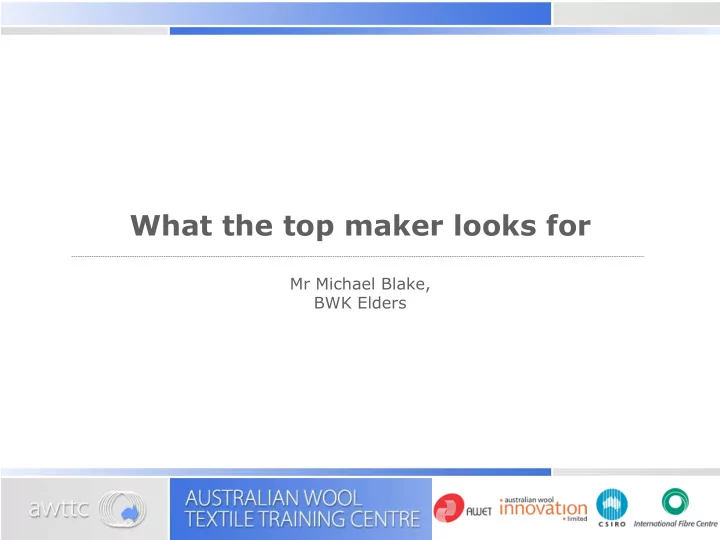

What the top maker looks for Mr Michael Blake, BWK Elders
Top making Raw wool demand Consumer demand Fashion / clothing manufacturers Weavers / knitters Worsted and woollen spinners Top maker Raw wool supply Australian for Agriculture
Industry demand and supply Wool Marketing Exporters Scouring/ Spinners Weavers/ Cut & Retail/ Growers Topmaking Knitters Sew Wholesale DEMAND DRIVEN – Forward orders SUPPLY DRIVEN – Auction Australian for Agriculture
Derived demand (raw wool) • Consumer trends • Processor requirements – Colour – Specific micron – Feel/ comfort – Low CVH – fashion – Elites – Eco/natural – Machine washable – Cost – Etc • Designer/fibre related • Service related – Weight – Reliable supply – Drape – Delivered on time – Handle/tactile – Repeatable performance – Surface appearance – High efficiency Australian for Agriculture Source: Stanton, J. (1998)
Two factors affecting top makers: 1. Cost and availability 2. Top specifications • Industrial cost of top making • Seasonality of supply • Demand from spinner • ‘Least Cost’ solution to specifications Australian for Agriculture
Share of final costs: wool Australian for Agriculture
1. Cost and availability topmaking costs • $1.00 $1.00 / kg kg – Funding – Fibre diameter – Exchange rates – Yield – Vegetable matter – Contamination – Clip preparation – Client risk – Labour costs – Credit risk – Electricity – Water • Raw material – Effluent – Efficiency – 70% of total – Expertise – Technology – Era combs Michael Blake Australian for Agriculture Source: The Wool Task Force (1999)
1. Cost and availability seasonality of supply • Wool availability throughout season – Supply-demand imbalance – Specific types at specific times – Access to fresh wool supply – Other origin wool • Stock holding costs – Financial – Storage capacity Australian for Agriculture
1. Cost and availability means of raw wool supply • Auction • Open mill orders • Private treaty • Futures • Traders forward sales • Electronic selling Australian for Agriculture
Two factors affecting top makers 1. Cost and availability 2. Top specifications • Requirements from spinner Australian for Agriculture
2. Top specifications worsted spinning 95 95 2/32Nm 90 2/36Nm 2/40Nm 85 2/44Nm Fibre length (mm) • Nm = m/g 2/48Nm 80 • yarn count 2/52Nm 75 – linear density 70 2/56Nm • 2/56 Nm 65 – 2 ply 60 – 56 m/g count 55 50 45 18 19 20 21 22 23 24 25 26 27 28 Fibre diameter ( µ m) Australian for Agriculture Source: Stanton, J. (1998)
2 - Top specifications assembling demand 95 95 90 85 High twist weaving yarns (crepe) 80 Fibre length (mm) Plain worsted 75 weaving yarns Wool/Polyester 70 worsted yarn Worsted 65 knitting yarn Woollen knitting yarns 60 Lambswool Knitting yarn 55 50 45 18 19 20 21 22 23 24 25 26 27 28 Fibre diameter ( µ m) Australian for Agriculture Source: Stanton and Coss (1995)
2. Top specifications spinners’ specifications Parameter 21.5 micron 18.5 micron 21.5 18.5 Diameter (micron µ m) - max 22.0 20.5 CV( µ m) – max 4.5 3.0 % >30 µ m – max Hauteur (H) – min 70.0 65.0 CV(H) – max 45.0 45.0 % < 25mm – max 7.0 7.0 % < 40mm – max 18.0 18.0 Soxhlet % - max 0.8 0.8 Neps per kg – max 40 40 Burrs per kg – max 10 10 P/Burr per kg – max 30 30 Shive per kg – max 20 20 P/Shive per kg – max 100 100 Slubs per kg – max 0 0 Coloured fibres per kg – 20 20 max Uster CV – max 3.75 3.75 pH – max 9.2 9.2 Sliver weight (g/m) 20 20 Ash content (%) 0.5 0.5 Australian for Agriculture
2. Top specifications wool top requirements Fibre related Technical / industrial • Micron • Oil content • Hauteur • Sliver weight • CVH • VM content • Short fibre content • Top colour • Colour • Final form • Coloured fibres – Bobbins – Bumps • Contamination • VM • Style • Repeatability Australian for Agriculture
Challenges in commercial top making 1. JIT requirement 2. Competition 3. Market risk 4. Price fluctuations 5. Keeping up to technology 6. Raw wool specification 7. Contamination 8. Wool availability 9. Predictability of results 10. Repeatability of top Australian for Agriculture
Recommend
More recommend